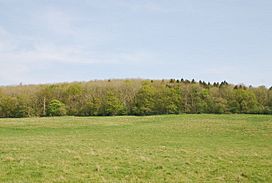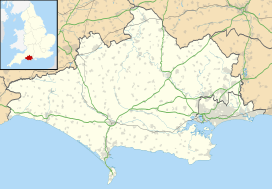Duncliffe Wood facts for kids
Quick facts for kids Duncliffe Wood |
|
|---|---|

A view towards Duncliffe Wood from the West
|
|
| Map | |
| Geography | |
| Location | Dorset, England |
| OS grid | ST825224 |
| Coordinates | 51°00′06″N 2°15′03″W / 51.0016°N 2.2507°W |
| Area | 92.16 hectares (227.7 acres) |
| Administration | |
| Governing body | Woodland Trust |
Duncliffe Wood is a very old and special forest located on top of Duncliffe Hill. You can find it a few miles west of Shaftesbury in England. This amazing woodland covers about 92 hectares (or 227 acres), making it one of the biggest ancient forests in North Dorset.
Contents
Discover Duncliffe Wood
Duncliffe Wood is not just any forest; it's an "ancient woodland." This means it has been continuously covered by trees for hundreds of years, even since the year 1600! It's a living piece of history.
A Long History of Duncliffe Wood
This forest has a really long and interesting past. It was even mentioned in a very old book called the Domesday Book back in 1086. At that time, it was owned by someone named Roger de Belmont.
Over many centuries, Duncliffe Wood changed hands several times. It was owned by a French nunnery, then became property of the King of England. Later, it was given to famous schools like Eton College and King's College, Cambridge, which owned it for 500 years!
Who Protects Duncliffe Wood Now?
In 1984, a charity called the Woodland Trust took over the care of Duncliffe Wood. They bought it from the Forestry Commission with help from other groups. The Woodland Trust works hard to protect and improve this important forest for everyone to enjoy.
How the Woodland Has Changed
For a long time, people used a method called "coppicing" in the wood. This means cutting trees down to ground level so they can grow back, which helps manage the forest. This was done until at least the 1930s.
The wood used to have many native trees like oak, ash, and hazel. However, in the 1960s and 70s, many trees were cut down and replaced with different types, mostly Norway spruce and some Japanese larch and beech.
Bringing Back Native Trees
Since the Woodland Trust took over, they have been working to bring back the original native trees. They are cutting down the non-native trees and planting new native ones. Sometimes, they even leave open spaces to help different kinds of wildlife.
Some of the oldest living things in Dorset are found here! There are lime trees in Duncliffe Wood that are thought to be between 600 and 1000 years old. Imagine how much history these trees have seen!
Wildlife in Duncliffe Wood
Duncliffe Wood is a great place for wildlife. It's especially known for its beautiful butterflies. If you visit, you might spot the silver-washed fritillary, the white admiral, or the purple hairstreak. These colorful insects add to the magic of the forest.


